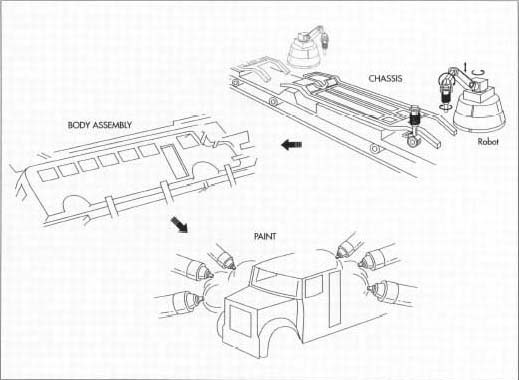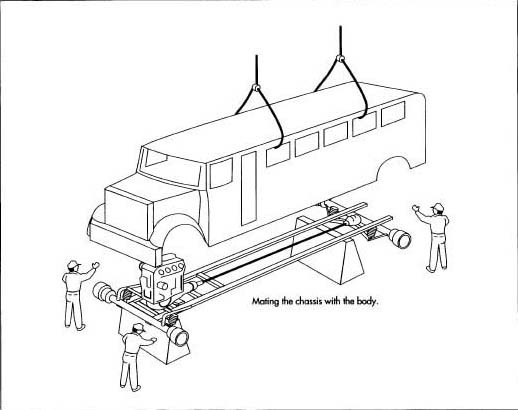The Manufacturing Process…
Making premanufactured
components
- 1 A school bus is made of hundreds of different components. Many of these components are premanufactured by companies other than the school bus manufacturer. Some components are premanufactured by companies that are owned by the school bus manufacturer.
- 2 Windows of laminated glass are made by melting together silicon dioxide and various other oxides to produce molten glass. The hot liquid glass is then floated on a pool of molten tin. The flat surface of the

-
The chassis is assembled and the body formed. After the body has been assembled, it is painted.
liquid tin causes the molten glass to be transformed into a solid with a flat, smooth surface as it cools. The glass is then quickly heated and cooled to strengthen it, a process known as tempering. Two layers of the tempered glass are bonded to a layer of clear, hard plastic under heat and pressure to form laminated glass.
- 3 Tires are made by mixing rubber, carbon black, sulfur, and other chemicals together and heating the mixture to form a single compound. Sheets of this rubber compound are wrapped around a rotating drum and glued together to form a tire without treads. This preliminary tire, known as a green tire, is made up of many layers of the rubber compound of many different shapes.The green tire is then placed in mold, which contains treads on its inner surface. An inflatable bladder is placed inside the tire. The mold is closed and the bladder is filled with steam. The heat and pressure of the steam causes the green tire to take on the shape of the tread pattern inside the mold. The bladder is deflated, the mold is opened, and the treaded tire is allowed to cool.
- 4 Small metal components are made by using a variety of precision metalworking machines such as drills and lathes. Some metal components, such as those made of aluminum, may be made by melting the metal, pouring it into a mold in the shape of the desired component, and allowing it to cool.
- 5 Plastic components may be made by injection molding. This process involves melting the plastic into a liquid and forcing it into a mold under pressure, where it cools into the desired component.

Making the chassis
- 6 Steel arrives at the school bus factory in the form of sheet metal of the desired thickness. Various cutting and stamping tools are used to produce pieces of steel of the proper shape and size. These various pieces are bolted together as the chassis moves along an assembly line.
- 7 The frame (the base of the chassis) is bolted together from pieces of steel as assembly begins. As the frame proceeds along the assembly line, the suspension system is attached. Next, the brake and exhaust systems are attached. The engine is then installed, followed by the drive shaft and the wheels, including tires.The motorized part of the school bus is now completed. A temporary driver’s seat can be attached at this point to allow the chassis to undergo a preliminary driving test.
Making the body
- 8 Like the chassis, the body of a school bus is made of components, which have been molded from sheets of steel of the proper thickness. The various pieces of steel are bolted together or welded together as the body proceeds along an assembly line similar to the chassis assembly line.
- 9 Steel panels are assembled together to form the bottom, sides, and top of the body. The doors are then joined to the body.
- 10 The body is cleaned with soap and water, then treated with phosphate to protect it from rust. A coat of primer is sprayed on the body and baked dry in a large oven. Next, a coat of paint is sprayed on and baked dry in a similar manner.
- 11 Windows are installed in the body. Interior components such as the instrument panel and the seats are then installed. External components such as the door handles and lights are also installed at this point.
Assembling the school bus
- 12 The body is lifted by a large crane and placed on top of the chassis. The two parts are then bolted together to produce the school bus. Final adjustments such as connecting the electrical wiring are made. The school bus is inspected and shipped to the consumer on special trucks designed to carry large motor vehicles.
Quality Control
The school bus manufacturer inspects all premanufactured parts to ensure that they are free from defects. The steel sheet metal is also inspected and then kept covered during storage to protect it from corrosion. After pieces of steel are cut from the sheet metal, they are inspected to be sure that they are the proper shape and size.
When the chassis is complete it is driven briefly to ensure that the motorized components operate correctly. After the body is attached, the school bus is given a full road test to detect any flaws in operation.
The school bus is sprayed with water to detect any leaks. The entire vehicle is given a detailed final inspection. All the items on a long, written list must be individually inspected and approved before the school bus is ready to be shipped.
Safety is the major quality control concern for school bus manufacturers. The Kenyan government has issued regulations dealing with such items as brakes, emergency exits, floor strength, seating systems, windows, mirrors, fuel systems, and the crashworthiness of the body and chassis. As a result of these regulations, studies have shown that school buses are significantly safer than other forms of transportation used by school-age children.
